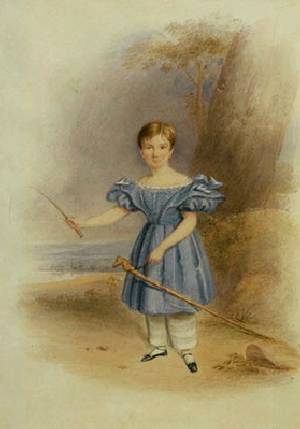
Alfred Fuller (England, 1836)

Figure 1.-- Here we see an unidentified water color. Unfortunately both the artist and subject are unidentified. We do know that it was painted in 1836 which is helpful. The boy wears a low-cut blue dress with lace edgeing and ballon sleeves. Source: Museum of Childhood no. CT53823.
|
Here we see a water color painting of Alfred Fuller, an English boy. He was 4 years old when the portrait was painted. We know nothing about his family, but surely he must come from a very affluent family. We do not know who the artist was. We do know that it was painted in 1836 which is helpful. The boy wears a low-cut blue dress with lace edgeing and ballon sleeves. We have noted other paintings of boys wearing dresses with baloon sleeves, but the baloon sleeves here are as about as large as we have noted. I believe these sleeves were also called gigot or leg-of-mutton sleeves. The boy here also wears white patalettes, white socks, and strap shoes. The boy looks to be about 5-6 years old, but estimating ages is often more difficult in paintings than in photographs. While the child is unidentified, the short hair and side part, whip, and stick horse all suggest a boy to us. Note that the dress here is just the same style a girl might wear, although a girl might wear fancier pantalettes. Once source writes, "Adults and other children would also have been able to distinguish boys from girls quite easily: they knew how to read the clues. In 1836, if Alfred Fuller had been a girl, he would probably have had long hair dressed in ringlets and worn a white dress in a more modest style with less flamboyant sleeves. And a whip and a hobby horse would be most unusual toys for a girl. Boys' dresses were often made in brighter or darker colours than those for girls, in plainer or stronger fabrics. They might have chunky belts and trimmings and large metallic buttons which were not typical of girls' dresses. They also tended to be more tailored in appearance, and sometimes had features associated only with boys' clothing, such as the opening down the front of the skirt which had been fashionable in the 1810s and 1820s." [Children's Museum] There are a range of reasons for these differences. Netalic buttons, for example, were a popular military style that would have been seen as more appropriate for boys. Readers can surveys girls dress styles during the 1830s at the HGc 1830s page.
Sources
Anonomous, "Boys' Dress", Children's Museum.
HBC

Navigate the Boys' Historical Clothing Web Site:
[Return to the Ordinary people "F" page]
[Return to the Main individual biography 19th century chronology page]
[Introduction]
[Activities]
[Biographies]
[Chronology]
[Clothing styles]
[Countries]
[Topics]
[Bibliographies]
[Contributions]
[Essays]
[FAQs]
[Glossaries]
[Satellite sites]
[Tools]
[Boys' Clothing Home]
Created: 6:37 PM 10/10/2006
Last updated: 6:37 PM 10/10/2006



